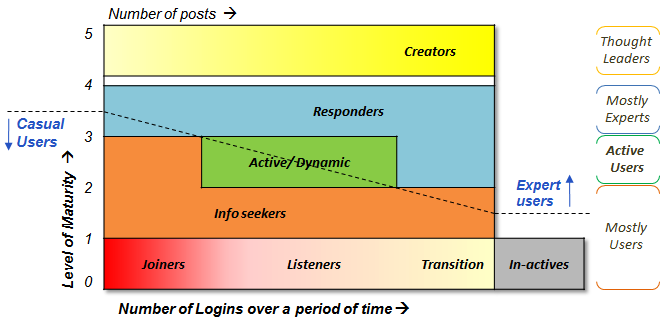INTRODUCTION
Everyone understands the value of grouping users. There are various ways to classify users but primarily they fall into one of the three levels defined below:
LEVEL 1: PRIMITIVE
This is the easiest and the most common way of grouping users. This Level is synonymous to a company in US trying to read books about Japan to understand their culture. The distance between the user and the organization is high. Beyond a certain point, this level fails to connect with the users.
Organizations can only take generic decisions based on the typical characteristics of this user group. Example, if an organization is developing a portal and it finds that 75% of its users are female and in the teenage group, they might target pink for the portal theme. But if this group happens to like rock music and partying, the organizations decision to go with pink could be a road to disaster.
LEVEL 2: PASSIVE
Levels-2 is all about studying the user passively but closely to understand their presence (where they are active), their behavior (what they do online) and their tastes (what they like). This is synonymous to a company in US sending someone to Japan to collect information. Inclusion of Level 1 grouping to this level would be an added advantage. A good starting point would be to analyze data captured from social media networks like Facebook, Twitter, etc.
LEVEL 3: ACTIVE
In this level, hand picked influencers are analyzed in depth from both an internal & external networks perspective. Right content (information, samples) is then pushed to this small group of handpicked few to create the impact. This levels termed “Active” because on identification of influencers, some amount of handshake/contact/personal touch happens with the influencer (user). Tools like Radian 6, Sysomos, Klout help in identifying these potential influencers. This level is hard, time-consuming and relatively expensive but has a higher pay-off .
Forrester’s User life-cycle
Forrester’s User life-cycle (Ref. Figure 2) categorizes users into 6 groups: Creators, Critics, Collectors, Joiners, Spectators and In-actives. This user life-cycle maps to Level 2 mentioned above as it can easily group users primarily based on their age and characteristic alone. But this does not tell you how many creators or critics in a particular age group posted only once. It is also not possible to determine how many of the joiners became inactive after the first login.
User Profiler
The profiler designed here (Refer Figure 3) categorizes users into 6 major groups: Joiner, Information seeker, Active/Dynamic, Responder, Creator and In-active. It is possible to map these groups to the Forrester’s user life-cycle groups with the exception of the Collectors group.
What do these categories mean?
Joiner: Moment a user registers they enter the Joiner level and take a default maturity of 0
Info Seeker: Users who seek answers to questions are the information seekers. Quality of the question decides the users’ maturity. Typically this ranges between 1 and 3
Active / Dynamic: These users actively seek information and respond to others in the group regularly. The maturity for these users range between 2 and 3
Responder: Responders are mostly users within the organization or industry experts. They either have the information or the resources required to secure the information needed for information seekers. Maturity lies between 2 and 4
Listener: These users log in and search for answers but have not posted anything yet. Mostly spectators. Beyond a certain point the lack of user activity except for login’s is either a BOT or Information collector (RSS)
Transition: This is the phase where the users tend to break the routine and shift to other sites or become inactive. One possibility is that the user has found what he/she was looking for
In-active: If the user does not have a single login in a say 1 year, the user is in-active and their maturity score drops to 0. This bucket helps identify and purge records easily for maintenance & performance purposes
Creator: Top management, visionaries and industry experts who are capable of generating interest in the public are Creators. Default maturity is assumed as 5.
Please feel free to get in touch with me if you have any queries or have suggestions around improving the above user profiler.
Categories: Social media
Tags: consulting, grouping, model, profiler, social media
Comments: No Comments.



